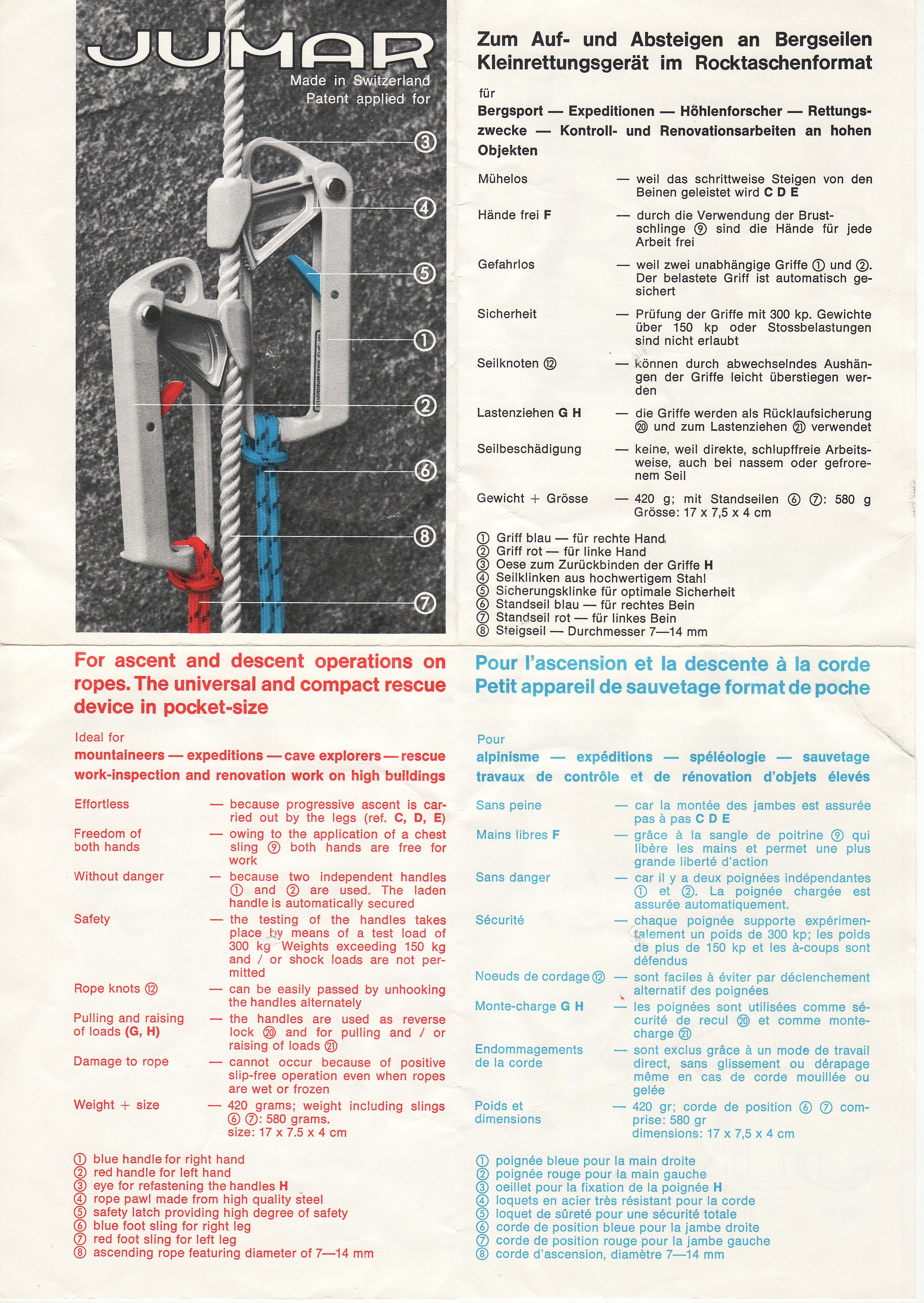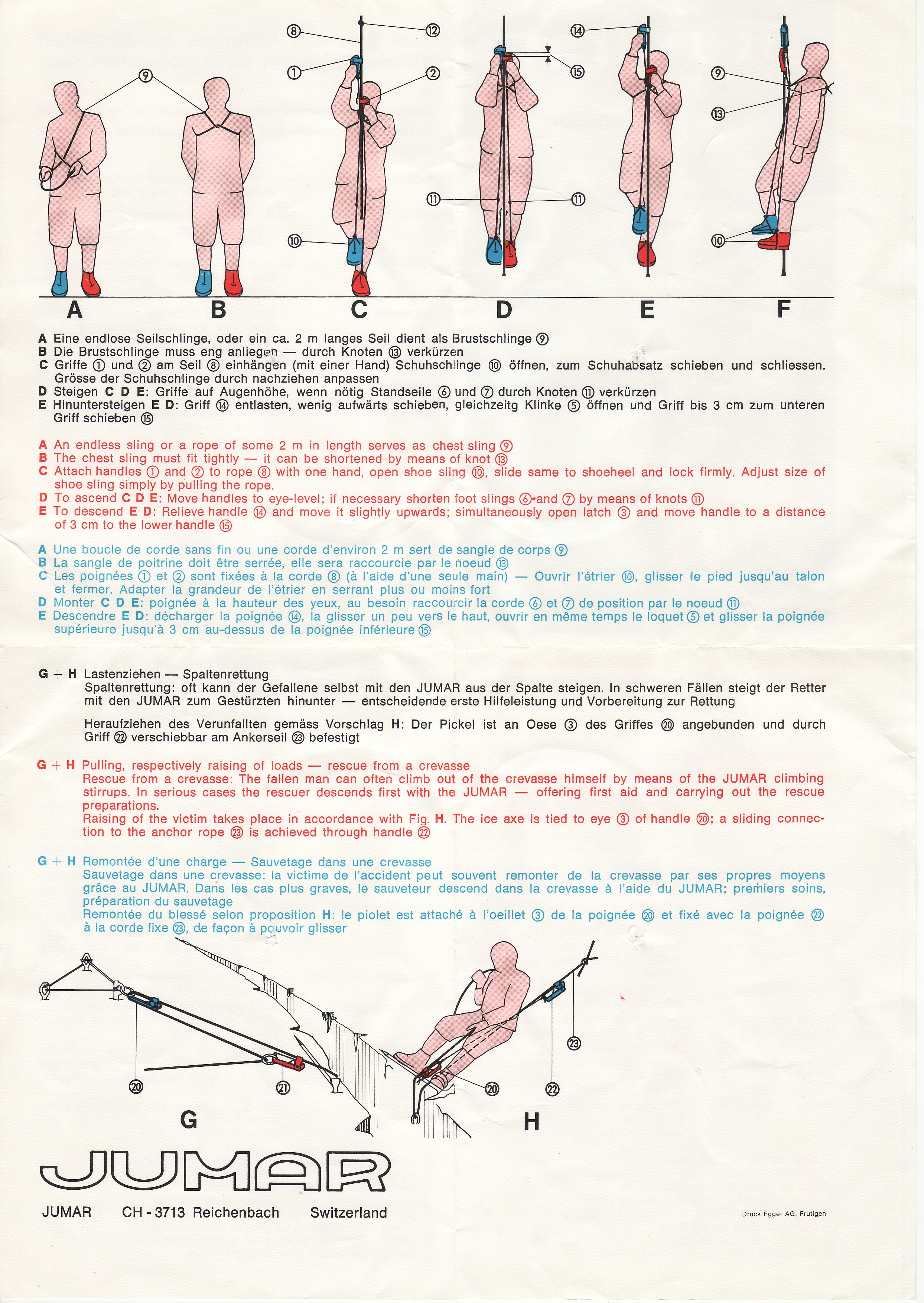Overview
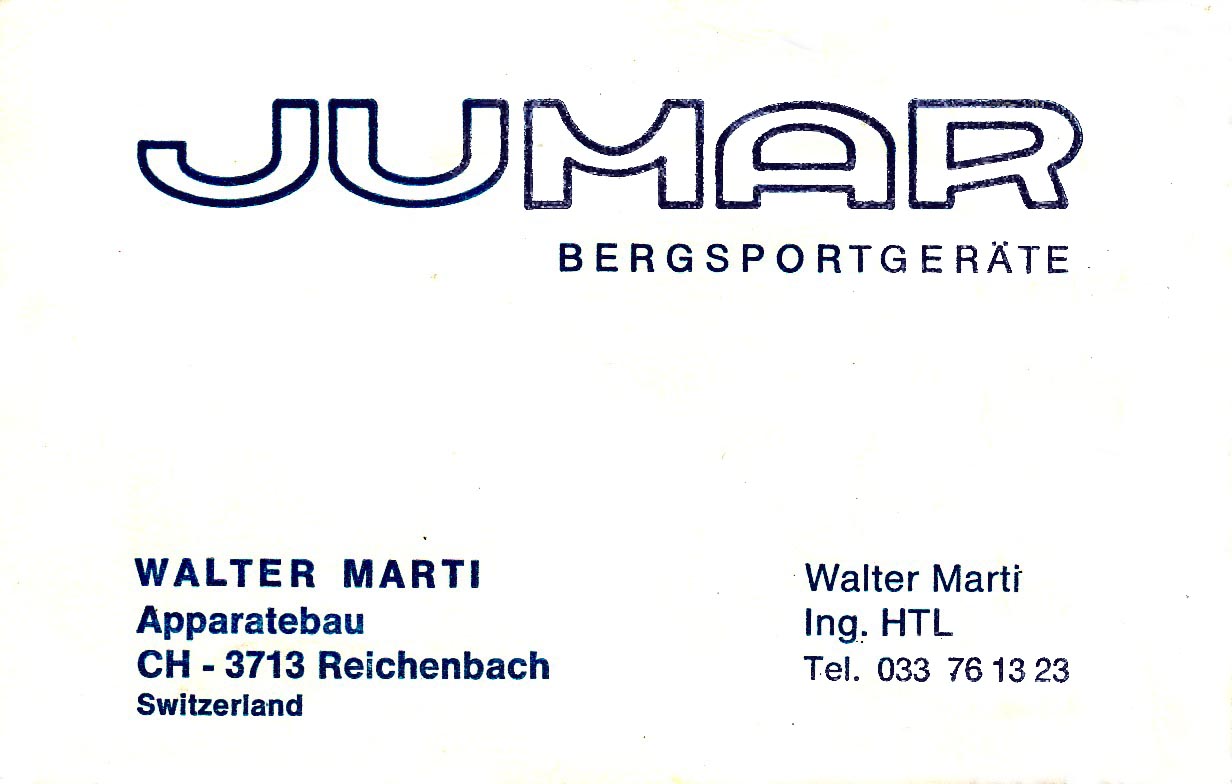 Jümar Pangit was a Swiss manufacturer located in Reichenbach, founded by Adolph Juesi (Jüsi) and Walter Marti. Mr. Juesi was studying eagles for the Swiss government and needed to ascend on ropes in order to perform his work, so Mr. Marti developed the ascender for him. In 1958, they introduced the first Jümar to the climbing market.
Jümar Pangit was a Swiss manufacturer located in Reichenbach, founded by Adolph Juesi (Jüsi) and Walter Marti. Mr. Juesi was studying eagles for the Swiss government and needed to ascend on ropes in order to perform his work, so Mr. Marti developed the ascender for him. In 1958, they introduced the first Jümar to the climbing market.
Originally spelled "Jümar," the umlat was dropped in many countries that do not use umlats in their native language.
In 1982 I was in Europe on business. One weekend I drove to Reichenbach to
meet Walter Marti, the designer and manufacturer of the Jumar
ascender. Mr. Marti shared a great deal of information with me
about his ascenders while his secretary, Mrs. Baumann, translated.
Both Mr. Marti and Mrs. Baumann were very friendly. One thing thatI learned during the visit was that there
are many variations of Jumar that were never put into
commercial production. I also saw early Jumars whose cams had "Z" shaped teeth similar to those found on the early
Clog ascenders. These are the ones described as "verzahntes bogenförmiges Ende" (serrated arcuate end) in Swiss Patent 362351. I am still looking for a pair of these early Jumars for my collection.
|
 |
Does anybody have a pair with the early z-tooth cams that you are willing to part with?
email me if you can help! |
|
Here is a quick summary of the versions shown on this page:
- Wide handle
(#1551)
- New cam paint
(#3581, 3649)
- New frame design.
(#1576,2172,3598)
- New cam tooth pattern.
(#136, 3580, 3599)
- Colored safeties instead of cams, shiny chrome cam.
(#2351, 2352)
- Dull cam.
(#236, 1506, 1549, 1550, 2001)
- Gray paint
(#36, 37, 272, 3509)
- Plastic safety.
(#38pr+L, 293, 1547, 1911, 2171, 2173, 2174, 3510)
- Blue paint
(#1535)
- Spring clip
(#118)
The coverage presented here is by no means exhaustive. As usual, I will only describe the models I own.
[ Top
| Version B
| Version C
| Version D
| Version E
| Version F
| Version G
| Version H
| Version I
| Version J
| Return to H.E.C. Ascenders
]
Version A
(#1551)
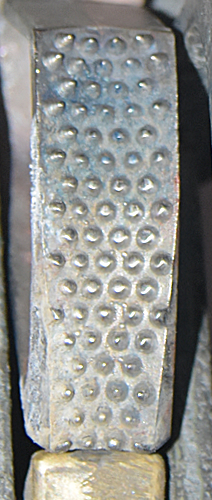 Technical Details
Technical Details
I acquired my Jumar, Version A pair from Steve Brandlein in 2011.
Version A is 162 mm. tall, 76 mm. wide, 37 mm. thick, and weighs 190 g. The rope channel is 14 mm. wide. The cam radius increases from 42 to 57 mm. over an angle of 39°, giving a 24° cam angle. The tooth pattern is (4.5)^6(4.3)^2(4).
The inside of the right ascender has a riveted plate printed with:
APPARATEBAU
MARTI
Reichenbach i.K. Switzerland
This is perhaps the earliest Jumar in my collection. The wording on the plate is interesting, since it does not refer to the ascender as a Jumar. It lists the manufacturer as Apparetebau Marti, not using the later name Jümar Pangit. Jumar ascenders were given Swiss Patent 362351 in 1962, with the original application dated March 22, 1958.
The main difference between this version and the following one is the handle, which has a much thicker spine than the later versions have. This reduces the room available for one’s fingers, although my large hand can still fit comfortably, unless I'm wearing thick gloves.
When I received these, they were rather corroded, but fully functional. and they cleaned up rather easily. The left and right ascender cams are painted red and blue, respectively. Most of the red paint has worn off my left ascender, but it is still clearly visible on the reverse side of the cam. A previous owner added some green paint to the left cam, and some green paint made it to the handle as well.
|
 |
There are earlier Jumars with cams that have "Z" shaped teeth similar to those found on the early
Clog ascenders, If you can help me find any for this collection, please
email me. |
|
[ Top
| Version A
| Version C
| Version D
| Version E
| Version F
| Version G
| Version H
| Version I
| Version J
| Return to H.E.C. Ascenders
]
Version B
(#3581, 3649)
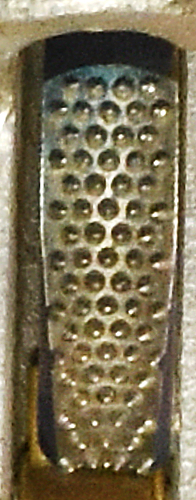 Technical Details
Technical Details
I acquired one Jumar, Version B pair with original slings from eBay seller theoldmanspicks in 2023. I obtained a second pair without slings from Gary Grant in 2024
Version B is 164 mm. tall, 77 mm. wide, 37 mm. thick, and weighs 193 g. The rope channel is 14 mm. wide. The cam axle is centered 57 mm. from the inside of the rope channel. The cam radius increases from 42 to 57 mm. over an angle of 39°, giving a 24° cam angle. The tooth pattern is (4.5)^6(4.3)^2(4).
The inside of the right ascender has a riveted plate printed with:
APPARATEBAU
MARTI
Reichenbach i.K. Switzerland
Version B cams have a larger painted areas than Version A cams,; otherwise, the two versions are identical.
The original slings are made from a natural fiber. Bob Thrun discussed this in Prussiking (1971, p. 18) as follows:
There is a common belief that the ropes at one time furnished with the Jumars were cotton. This is not so. The best identification that I have gotten is "probably linen." If this is true, the strength is about 1200 lbs.
[ Top
| Version A
| Version B
| Version B
| Version D
| Version E
| Version F
| Version G
| Version H
| Version I
| Version J
| Return to H.E.C. Ascenders
]
Version C
(#1576, 2172, 3598)
Technical Details
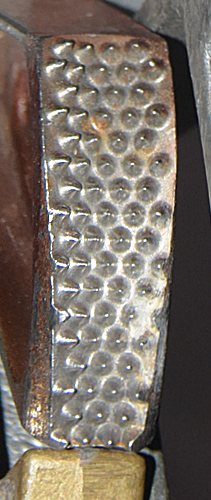 I acquired my Jumar, Version C from Don Harper in 2012. I acquired another pair in 2017 as part of Bob Thrun’s collection, and a left-handed one from Michael Oatney in 2023.
I acquired my Jumar, Version C from Don Harper in 2012. I acquired another pair in 2017 as part of Bob Thrun’s collection, and a left-handed one from Michael Oatney in 2023.
Version C is 162 mm. tall, 75 mm. wide, 36 mm. thick, and weighs 209 g. The rope channel is 13 mm. wide. The cam radius increases from 42 to 60 mm. over an angle of 41°, giving a 27° cam angle. The tooth pattern is (4.5)^6(4.3)^2(4).
Version C has a new handle design that allows more room for the fingers. Despite the reduction in the handle width, this version weighs 19 g more than its predecessor. I cannot account for the difference - perhaps the aluminum alloy is different?
[ Top
| Version A
| Version B
| Version C
| Version E
| Version F
| Version G
| Version H
| Version I
| Version J
| Return to H.E.C. Ascenders
]
Version D
(#136, 3580, 3599, 3662)
Technical Details
I acquired a pair of Version D Jumars at the NSS Convention Auction
in 1999, and one right-hand one each from Graeme Smith and Michael Oatneyin 2023. In 2005 I bought another pair on eBay from Roger Crafton.
Version D is 161 mm. tall, 76 mm. wide, 37 mm. thick, and weighs 207 g. The rope channel is 14 mm. wide. The cam radius increases from 42 to 60 mm. over an angle of 41°, giving a 27° cam angle. The tooth patte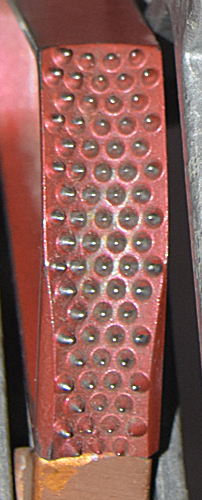 rn is (4.5)^5(4.3)^4.
rn is (4.5)^5(4.3)^4.
The cam is slightly larger than the one in the previous version, and the tooth pattern is different.
This is an earlier ascender dating from the 1960s. It is mechanically identical to the immediately following versions, but the cams are color-coded instead
of the safeties. Both safeties are anodized gold. The frame is
painted with a speckled metallic gray paint instead of a uniform
gray paint.
[ Top
| Version A
| Version B
| Version C
| Version D
| Version F
| Version G
| Version H
| Version I
| Version J
| Return to H.E.C. Ascenders
]
Version E
(#2351, 2352)
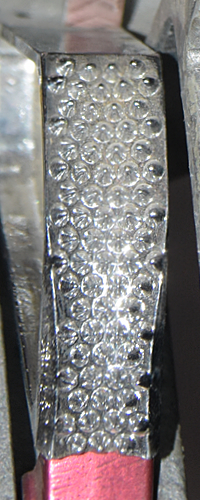 Technical Details
Technical Details
I acquired a left-handed Jumar, Version E from Austin Habitat for Humanity in 2017, and a complete pair from James Haerr later the same year.
The Jumar, Version E is 162 mm.
tall, 76 mm.
wide, 38 mm.
thick, and weighs 208 g.
The rope channel is 14 mm.
wide. The cam radius increases from 42 to 60 mm. over an angle of 41°, giving a 27° cam angle. The tooth pattern is (4.5)^5(4.3)^4.
The cam on this version is chrome-plated. This should make the teeth more wear-resistant. None of my ascenders of this version show much wear, not even inside the rope channel, so I cannot say for sure, but at least the teeth on all three ascenders in my collection look brand new.
[ Top
| Version A
| Version B
| Version C
| Version D
| Version E
| Version G
| Version H
| Version I
| Version J
| Return to H.E.C. Ascenders
]
Version F
(#236, 1506, 1549, 1550, 2001)
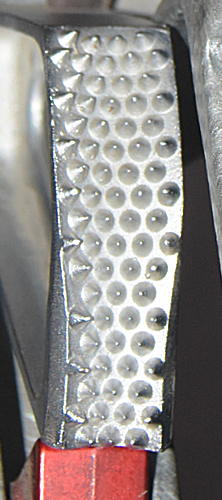 Technical Details
Technical Details
I acquired my Jumar, Version F on eBay from Karla Green in
2008. I acquired a second pair along with the original slings on eBay from Simon Cox in 2009. I picked up two more pair, one from Charles Wilkes in 2010 and another from Chris Vandiver, in 2011 (given to Артём Бабин), and a pair from Greg Estes in 2015.
Version F is 162 mm. tall, 76 mm. wide, 38 mm. thick, and weighs 210 g. The rope channel is 14 mm. wide. The cam radius increases from 42 to 60 mm. over an angle of 41°, giving a 27° cam angle. The tooth pattern is (4.5)^5(4.3)^4.
This is an earlier ascender than Version G. It is mechanically identical, but frame is painted with the same
type speckled metallic gray paint as Version D.
[ Top
| Version A
| Version B
| Version C
| Version D
| Version E
| Version F
| Version H
| Version I
| Version J
| Return to H.E.C. Ascenders
]
Version G
(#36, 37, 272, 3509)
Technical Details
I acquired this pair of ascenders used from Roy Jameson at
the 1980 N.S.S. Convention. They were originally purchased in
the early 1970s. I acquired a duplicate pair from John Yost in
1993, a left ascender from Karl Wilcox in 2009, and a right-hand ascender from eBay seller cptnamerica2003 in 2022.
Version G is 161 mm. tall, 76 mm. wide, 38 mm. thick, and weighs 211 g.
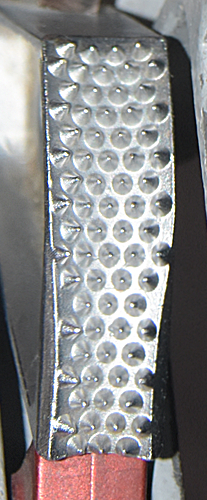 The Jumar frame is an aluminum alloy casting covered with a
gray epoxy(?) paint. The frame has a 14 mm. wide rope channel cast into one
side. The handle is roughly rectangular. A 21.6 by 13.8 mm.
rectangular hole in the base of the handle provides access for
the sling ropes. A triangular hole above the cam provides an upper
attachment point for auxiliary slings.
The Jumar frame is an aluminum alloy casting covered with a
gray epoxy(?) paint. The frame has a 14 mm. wide rope channel cast into one
side. The handle is roughly rectangular. A 21.6 by 13.8 mm.
rectangular hole in the base of the handle provides access for
the sling ropes. A triangular hole above the cam provides an upper
attachment point for auxiliary slings.
The cam is a skeletonized stainless steel casting. The cam
and cam spring are attached by a 5 mm. semi-tubular rivet. A steel
washer keeps the semi-tubular rivet from pulling into the aluminum frame.
The cam face is very well designed, with a concave surface whose
radius decreases from top to bottom along the cam surface in order
to compensate for different size ropes. The cam radius increases from 42 to 60 mm. over an angle of 41°, giving a 27° cam angle. The conical cam teeth
are aligned perpendicular to the cam face. The tooth count is
(4.5)^5(4.3)^4. The cam safety and safety spring are mounted on
a 4.5 mm. pin located about half way down the handle. The
cam safety is a piece of anodized aluminum, red for left-handed
ascenders and blue for right. This color coding has been maintained
on all later model Jumars. The cam safety physically blocks the
cam from opening far enough to allow the main rope to slip out
of the rope channel. Rotating the cam safety towards the base
of the ascender provides clearance for the cam to open completely.
The Jumar began to appear in American caving circles in the
early 1960s, and has probably remained the most popular mechanical
ascender since that time.
This model, like all Jumars, is very well made. All parts are
finished, and there are no sharp edges exposed anywhere. "Gray"
series Jumars are probably the easiest handled ascender to operate
one-handed. There is little if any difference in difficulty in
using either hand. My technique is to open the safety with the
middle finger, then open the cam with the thumb (of the matching
hand) or forefinger (of the opposite hand). The entire sequence
reduces to one fast, fluid motion with very little practice.
The major drawback of the early Jumars is the method provided
for sling attachment. The correct method involves bringing the
slings up through the square hole in the base of the Jumar and
around the back of the handle. THIS IS NOT A COMPLETE DESCRIPTION
SO DO NOT TRY THIS WITHOUT INSTRUCTION! It is unsafe to simply
loop the sling through the handle, since this places the load
on the thin, weak area at the base of the front strap. The front
strap (brace) can then break under tension. There have been several
reports of ascender failure resulting from this mistake (Davison,
Don Jr., Hits and Near Misses, N.S.S. News, v 34, #5, May 1976,
p. 80; Davison, Don Jr., Hits and Near Misses, N.S.S.
News, v 35, #4, April 1977, p. 73). It is not clear whether
the broken Jumars were Version D, B, C, D,
or some other version. Eventually the 78 (yellow) series Jumar
was developed to eliminate this perceived problem.
The color coded safety on the Jumar is nice, and suggests an
even more practical idea: color coding one’s left and right foot
slings. Because of the universal availability of the Jumar, the
red=left, blue=right scheme is an obvious choice. Old-school Petzl
users might prefer a yellow left sling instead.
[ Top
| Version A
| Version B
| Version C
| Version D
| Version E
| Version F
| Version G
| Version I
| Version J
| Return to H.E.C. Ascenders
]
Version H
(#38, 293, 1547, 1911, 2171, 2173, 2174, 3510)
Technical Details
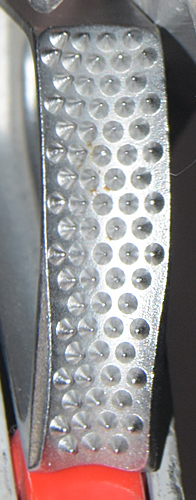 I acquired this pair of ascenders from Speleoshoppe at the
1976 N.S.S. Convention. I acquired another pair from Dean Berkbigler in 2009, and a third from Alexander Medrano in 2011, all on eBay. I acquired three more pairs in 2017 as part of Bob Thrun’s collection, and a right-hand ascender from eBay seller cptnamerica2003 in 2022.
I acquired this pair of ascenders from Speleoshoppe at the
1976 N.S.S. Convention. I acquired another pair from Dean Berkbigler in 2009, and a third from Alexander Medrano in 2011, all on eBay. I acquired three more pairs in 2017 as part of Bob Thrun’s collection, and a right-hand ascender from eBay seller cptnamerica2003 in 2022.
Version H is 157 mm. tall, 74 mm. wide, 36 mm. thick, and weighs 206 g. The rope channel is 14 mm. wide. The cam radius increases from 42 to 60 mm. over an angle of 41°, giving a 27° cam angle. The tooth pattern is (4.5)^5(4.3)^4.
This version is very similar to the previous one. There
are some minor variations in the frame design. The rope channel
is mounted lower on Version H, and so the force generated
by the cam on the rope is more nearly centered. The area behind
the cam leading to the rope channel was changed. Version D
had a concavity behind the cam and a corresponding arch on the
back side of the frame. Version G is flat behind the cam,
and concave between two reinforcing ribs on the back side of the
frame. "+GF+K9681" is cast in this concavity. The upper
end of the cam channel is cast over in Version G, but in
Version H it is open, and a stamped sheet metal cam housing
is used instead. The handle area has been made smaller in depth.
The details around the sling attachment hole are changed, with
Version G being less bulky. The hole has been reduced to
24.5 by 10.4 mm.
The cam safety has been changed from aluminum to plastic, and
is slightly smaller.
None of the changes mentioned seem to have a significant impact
on any of the performance characteristics of the ascender. The
only advantage Version H has over Version G is a slightly
lighter weight.
[ Top
| Version A
| Version B
| Version C
| Version D
| Version E
| Version F
| Version G
| Version H
| Version J
| Return to H.E.C. Ascenders
]
Version I
(#1535)
Technical Details
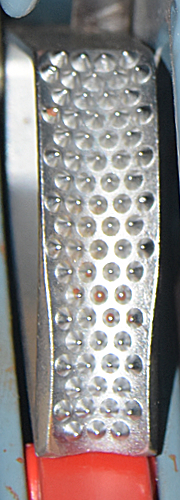 I acquired my Jumar, Version I from Craig B. Clark in 2010.
I acquired my Jumar, Version I from Craig B. Clark in 2010.
Version I is 160 mm. tall, 74 mm. wide, 36 mm. thick, and weighs 203 g. The rope channel is 14 mm. wide. The cam radius increases from 41 to 59 mm. over an angle of 41°, giving a 27° cam angle. The tooth pattern is (4.5)^5(4.3)^4.
The only difference between Versions F and E is the color of the paint, and that "+GF+K9684" (not "+GF+K9681") is cast in the concavity on the rear of the left ascender.
This is the only Jumar I've seen with dark blue paint. Examining the finish, how it extends under the cam rivet and the sticker inside the shell, and the edges of the scratches penetrating to bare metal convinces me that the dark blue finish is original. On the other hand, the red in the rear behind the cam area was probably added by a previous owner. The edges of the red are not straight, and there are red paint smudges in other places on these ascenders.
[ Top
| Version A
| Version B
| Version C
| Version D
| Version E
| Version F
| Version G
| Version H
| Version I
| Return to H.E.C. Ascenders
]
Version J
(#118)
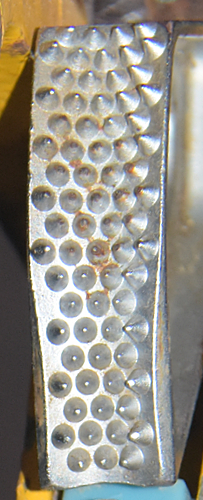 Technical Details
Technical Details
I acquired my Jumar, Version J from Theresa Williams and Maury Benamy in 1995.
This version is 159 mm. tall, 76 mm. wide, 32 mm. thick, and weighs 213 g. The rope channel is 14 mm. wide. The cam radius increases from 42 to 60 mm. over an angle of 41°, giving a 27° cam angle. The tooth pattern is (4.5)^3(4.3)^3. It has a spring-wire clip at the base. The
safety has a countersink head wood screw added to serve as cam
hold-open catch (added by a previous owner).
The initials "KK" are stamped into the frame.
This Jumar puzzled me for about twenty years. It is essentially the same as Version H, even down to the "+GF+K9681" cast into the frame,
but it is painted yellow. The paint is peeling off, but inside
the frame there is a remnant of the original Jumar label over
the paint, and the paint also runs under the cam rivet, so it
appears that the paint was original. On the other hand, the cam
looks unused while the rest of the ascender looks abused, so this
may be a replacement cam, and a replacement sticker could have
been added later. A touch of red paint on the pivot cover suggests
a later repainting as well.
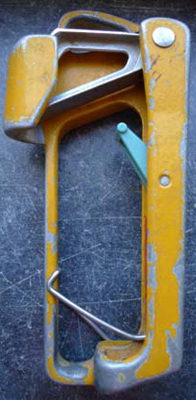
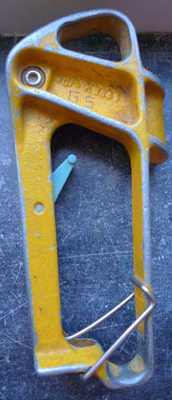 I included this ascender because of the spring-wire clip at
the bottom. It is well-made, and for a long time I wondered if it was original
or was added by a previous owner. I suspected the latter, but on Halloween in 2015, Bernard Sebille sent me a note saying that it was original. He has one as well, and included the photos of his that I include here. Thank you, Bernard!
I included this ascender because of the spring-wire clip at
the bottom. It is well-made, and for a long time I wondered if it was original
or was added by a previous owner. I suspected the latter, but on Halloween in 2015, Bernard Sebille sent me a note saying that it was original. He has one as well, and included the photos of his that I include here. Thank you, Bernard!
I think the clip is a bad idea, because it implies that you can tie in
to this type of jumar by tying around the frame instead of using
the square hole at the base the way it was designed. There have been several reports of
ascender failure resulting from this mistake (Davison, Don
Jr., Hits and Near Misses, N.S.S. News, v 34, #5, May 1976, p.
80; Davison, Don Jr., Hits and Near Misses, N.S.S.
News, v 35, #4, April 1977, p. 73). I believe the clip was intended to guide the sling
to the beefier side of the lower frame, and the wear marks on this side of the frame support this interpretation.
[ Top
| Version A
| Version B
| Version C
| Version D
| Version E
| Version F
| Version G
| Version H
| Version I
| Version J
]



 Jümar Pangit was a Swiss manufacturer located in Reichenbach, founded by Adolph Juesi (Jüsi) and Walter Marti. Mr. Juesi was studying eagles for the Swiss government and needed to ascend on ropes in order to perform his work, so Mr. Marti developed the ascender for him. In 1958, they introduced the first Jümar to the climbing market.
Jümar Pangit was a Swiss manufacturer located in Reichenbach, founded by Adolph Juesi (Jüsi) and Walter Marti. Mr. Juesi was studying eagles for the Swiss government and needed to ascend on ropes in order to perform his work, so Mr. Marti developed the ascender for him. In 1958, they introduced the first Jümar to the climbing market.